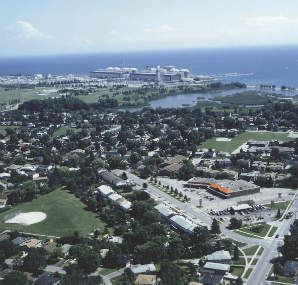
The Canadian Nuclear Safety Commission (CNSC) has completed a study on populations living near Ontario’s three nuclear power plants (NPPs). No evidence was found of childhood leukemia clusters in the communities within 25 km of the Pickering, Darlington and Bruce NPPs.
The Radiation and Incidence of Cancer around Ontario Nuclear Power Plants from 1990 to 2008 study (the RADICON study) estimated radiation doses to members of the public living within 25 km of the three NPPs and compared cancer cases among these people with the general population of Ontario. The study was conducted using data from the Canadian and Ontario Cancer Registries and the Census of Canada.
"This is an important study," said CNSC President Dr. Michael Binder. "We often hear concerns from the public about a possible link between childhood leukemia and radiation from nuclear power plants. We now have Canadian data to reassure them with science-based and conclusive evidence that children living nearby are as healthy as children living elsewhere in Ontario."
Overall, the study found that all cancers are well within the natural variation of the disease and there is no consistent pattern across the three facilities studied. When looking at all age groups, some cancers were higher than expected and some cancers were lower than expected. The most likely causes of cancer in the communities are a number of known health risk factors.
"Sixty percent of all cancers in Ontario are due to smoking, obesity, poor diet and physical inactivity," said Rachel Lane, epidemiologist and lead researcher on the RADICON study. "Other studies have found that these health risk factors explain the pattern of cancers in Ontario communities. These health risk factors are the most plausible cause of cancer – not radiation."
CNSC said that the main strength of the RADICON study is the use of detailed public dose information around each NPP that was generated from radiological releases and environmental monitoring data. The data collected for this study takes into account any emission spikes from the NPPs. This methodology improves on recent epidemiological studies of childhood cancer that have used distance from an NPP as a substitute for radiation dose. Doses closest to the NPPs were not consistently higher than doses further away. Many factors influence doses to the public as a result of the operation of a NPP, including prevailing wind directions and lifestyle characteristics (i.e., diet and lifestyle habits) of the surrounding communities. Therefore, distance is not a good substitute for dose.
Public radiation doses from Ontario NPPs are extremely low: 100 to 1,000 times below natural background radiation. In Canada, average background radiation is 1.8 millisieverts per year.
Picture: community around the Pickering site
The survey is available via this link:
http://www.nuclearsafety.gc.ca/eng/pdfs/Reading-Room/healthstudies/Radiation-Incidence-Cancer-Around-Ontario-NPP.pdf






